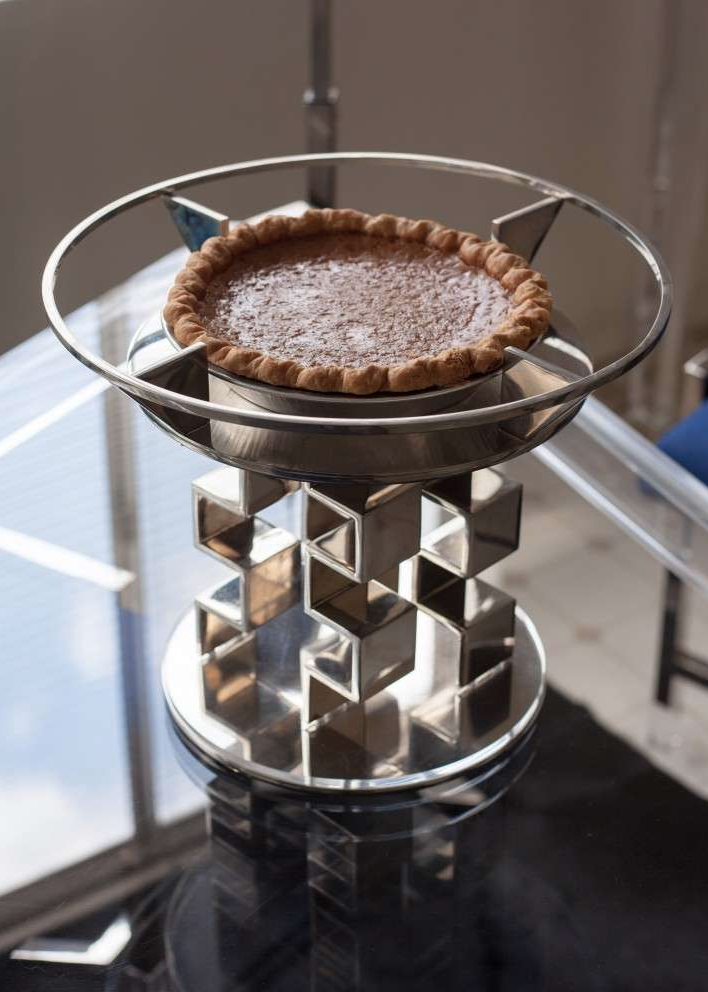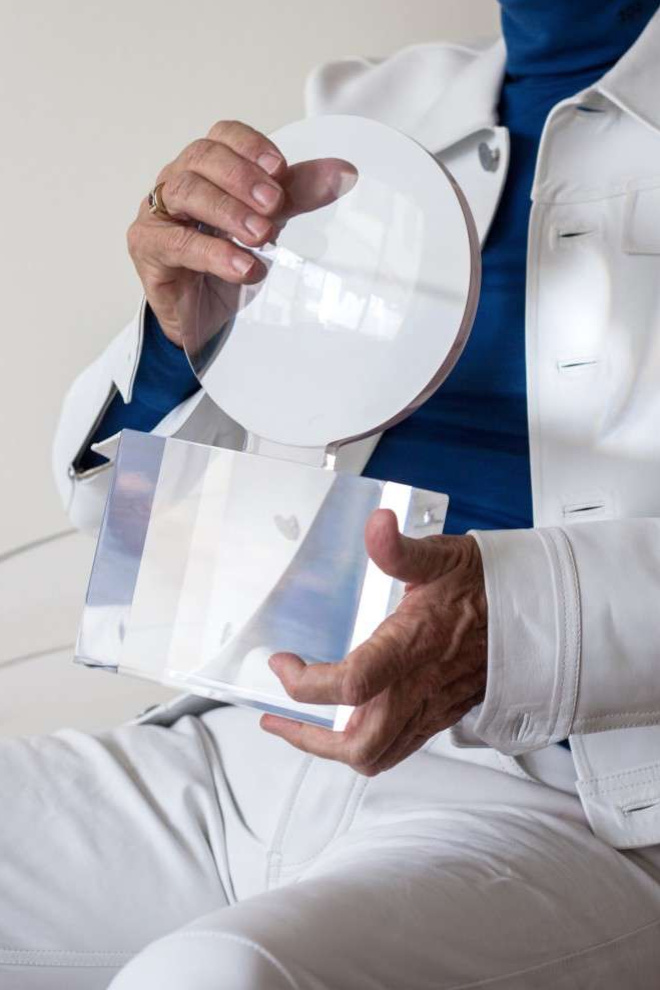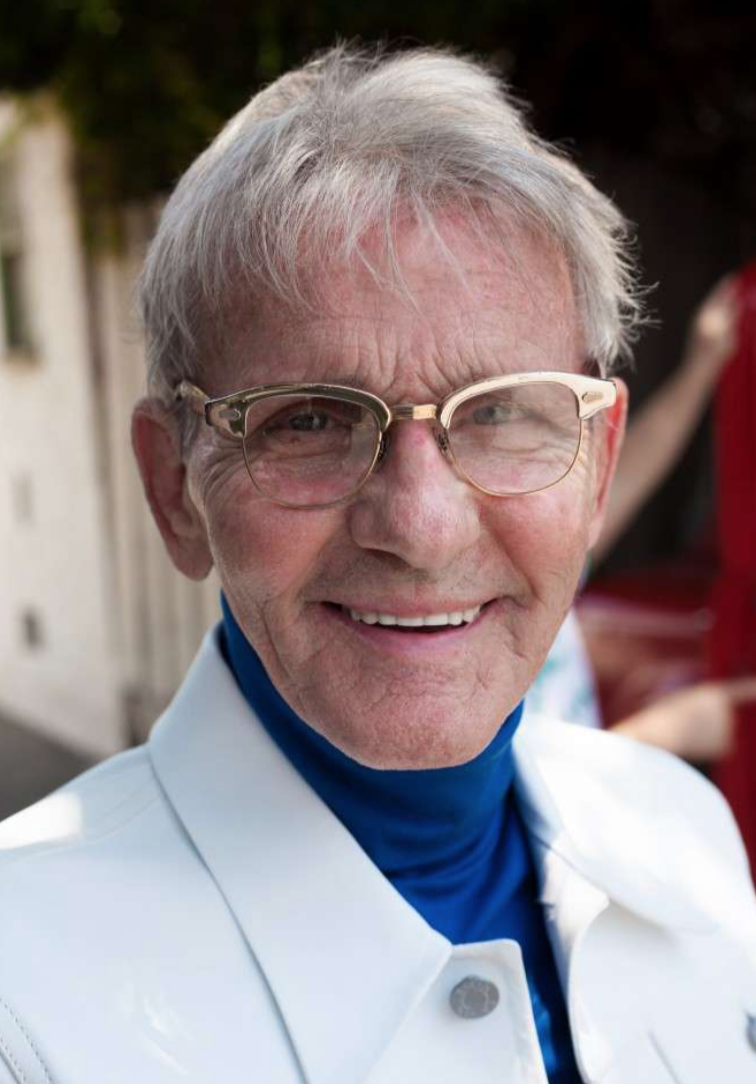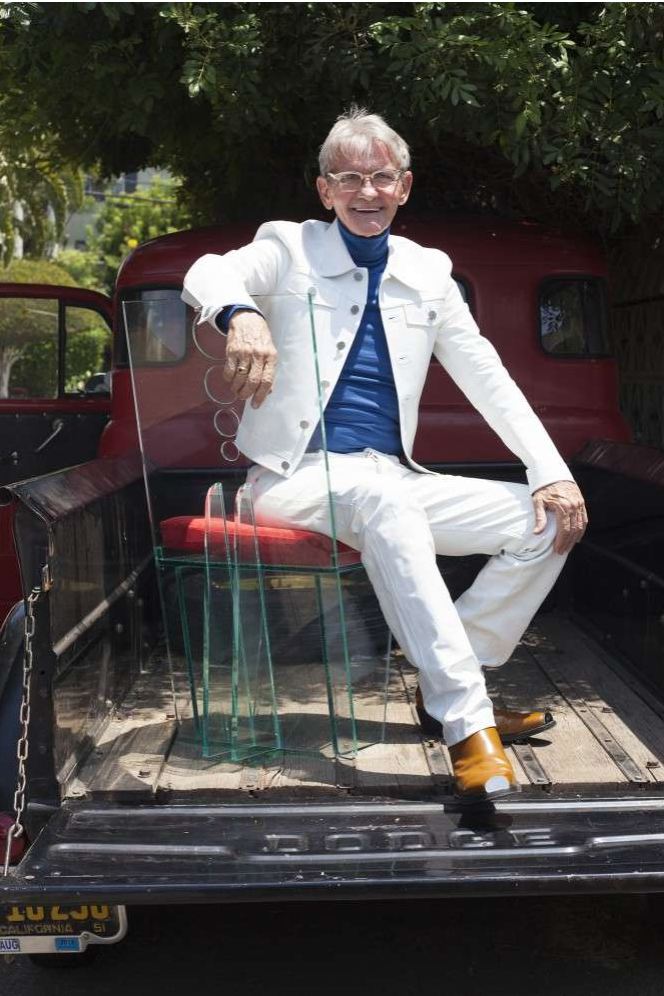CHARLES HOLLIS JONES
Interview by Michael Bullock
Photography by Ramsey Alderson
PIN-UP, 2018

THE INCREDIBLE MR. LUCITE
The story of Charles Hollis Jones begins like the rise of a typical Hollywood heartthrob: a good-looking, confident young man with high hopes and a big personality comes to L.A. to make his mark. But in Hollis’s case, a talent for design and an obsession with poly methyl methacrylate — best-known by one of its tradenames, Lucite — set him on a fabulous, uncharted path. In his 50-year career, the sprightly septuagenarian has created over 1,000 designs, combining aesthetic ingredients that are as American as apple pie: a pinch of his mother’s quilt patterns, a dash of Modernism, and an extra-large helping of over-the-top Hollywood opulence. It’s a formula that has consistently paid off, delivering what each decade’s brightest talents needed to make them feel like stars while relaxing in the privacy of their own homes — from the Rat Pack and Lucille Ball to Sylvester Stallone and the Kardashians. In a career fueled by bold-faced names, it only makes sense that his most famous design, the 1968 Wisteria chair, was born out of his friendship with the legendary playwright Tennessee Williams. (He’s also most likely the only furniture designer to have two songs in his honor: one by crooner Dean Martin from 1968 and another by punk singer Grant Hart from 2009.) Parallel to his pop cultural pedigree, Jones is probably also the only furniture designer to ever collaborate with the two Johns that represent the opposing poles of mid-century California design: John Elgin Woolf, god-father of Hollywood Regency, and John Lautner, the organic futurist. Jones received PIN–UP in his showroom in Burbank, Los Angeles, whose unassuming exterior in a decidedly unglamorous housing estate contrasts spectacularly with the shimmer, shine, and sparkle of the furniture inside. While in the company of the very entertaining “Mister Lucite,” one thing becomes crystal clear: celebrities and looks may have changed over the years — but Jones’s passion for Lucite remains as strong as ever.
So you grew up in Bloomington, Indiana?
Here comes the hillbilly. [Laughs.] Yes. That’s where I was born. But my parents were originally from Kentucky.
I read that your mother was a quiltmaker, your father a farmer, and that you attribute much of your design inspiration to them.
They were Modernists. It’s unusual for farmers to be Modernists. Bloomington is particularly liberal because of Indiana University. Mom worked at the university as a pastry cook. So I love pie. That’s my pie stand right there. [Points to one of his classic designs.] We don’t call it that because you’d never sell it as a pie stand. We say it’s a container, and then people put lemons in it... or nothing. But I get a pie delivered to me every Friday morning and by the time Monday comes I’ve eaten the whole thing. I just love pie!

What did your mother’s quilts look like?
They inspired the chair you’re sitting on, and that table. I titled that line Tumbling Block because that’s the name my mother gave to the quilt I got the idea from. It looks like a square getting smaller and smaller or tumbling down. That chair is just like her quilts.
And what about your father?
We lived on a farm, but his main business was selling lumber. He owned a sawmill and sold patterns for houses. He gave you three choices: split-level, ranch-style, or a two-story. He won contracts to make so many a year. People came from everywhere. From him I learned that you could live on a farm and meet anybody. I would watch my dad take off the roofs and siding of a lot of bridges. In Indiana we had the most restored bridges in the United States. Seeing all that being taken off and then put back on again, I would think, “Wow, what a great lampshade that structure would make.”
So how did a teenage farmer’s son end up in Hollywood?
My parents encouraged me to leave. They didn’t think Bloomington was right for me. I worked at a Howard Johnson’s, and my mother always asked me, “Are you Richard Burton? Are you Frank Lloyd Wright? Or are you a manager of a Howard Johnson’s?” My older brother fought in the Korean War with a guy named Joe Roide who owned Joe Roide Enterprises, a Lucite factory in downtown L.A. So in 1961, when I was 16, I went for a summer to work for him. My brother introduced me as a designer so that’s what he hired me to do.
Wow, lucky break...
Are you kidding me? More than luck — I was handsome!
[Laughs.] I see that.
In L.A. I met lots of people and my life changed. I made more money than I knew what to do with. I became important. [Laughs.] And I drank and abused it. I always designed... for big people though. Women that had connections with people like Bill Marriott [of hotel fame]. I worked for him. I designed chairs and lamps for his place in Palm Springs.
When you started out, which designers did you look up to?
Paul László was important for me. After I’d been with Joe a while, he got me a job at Hudson-Rissman. It was the biggest furniture showroom of the time. He figured that that way I could meet all the decorators and sell them the pieces I made at his factory. Paul shopped there and we became friends. His training was Bauhaus but he lived in Beverly Hills. In that period, he was decorating his head off and not doing architecture at all.
He bought your work?
I made furniture with him and for him, forever. He didn’t talk much because he stuttered, but he’d always say to me as he was leaving, “Make it look the money, cause I’m charging a lot.” So I’d make it bigger and better. I’d get $800 or $900 for a lamp and we’re talking the late 1960s. If Paul was still alive, he’d be about 110 today.
I heard you have a thing against four-legged chairs?
Credenzas, ottomans, coffee tables, chairs, everything has four legs. They look like they’re ready to get up and walk right out of the room. Why can’t we think of a table without saying the word “table”? How can I language that to a student or to myself. Let me pretend I’m teaching. I say, “Design me a structure that’s 18 inches off the floor and that can support a small bowl.” You’d be surprised what students come up with. I realized I could reconstitute my conception if I stopped naming things before I started designing. If I design a T-A-B-L-E without thinking of the name then I can pretend I’ve never seen one. I started thinking that way and I never came up with four legs.

Is it true that you also hate color?
In the 60s, if I’d seen one more piece of Venetian glass I would have screamed. Although one of my most successful chairs is the one I did for Tennessee Williams, with the edges dyed green to look like glass.
How did you end up collaborating with Tennessee Williams?
The first time I met Tennessee he visited my showroom and asked, “If I buy one of your designs from you, will you have a drink with me?” I told him, “You don’t have to buy anything of mine, we’ll go have a drink anyway.” We went out that evening and our cocktail waitress came over and said, “You remind me of Tennessee Williams,” and he said, “You know what, I get that all the time.” That’s how we started.
So he had a romantic interest in you?
I don’t think so. I think he just liked to be around me. I never gave any of those rich famous men anything except my time, and if they wanted my time they had to buy my work. But they would never get anything else, absolutely none of that.
And you and Tennessee became friends?
Yeah. He was crazy though. Drug addict, alcoholic, he loved whiskey, although I never saw him drink until after three in the afternoon. He was famous for his drama and he even loved to create it in his own life. He’d say to me, “We’re going to Jane Fonda’s tonight and they’re gonna read my script. And at some point, I’m going to get up and tell them it’s the worst thing I’ve ever heard in my life, then I’ll pretend to fall, and you’ll say, ‘I’ve got to take him home,’ and we’ll leave.” It was always choreographed ahead of time. I’m not an actor, but he’d convince me that’s what was going to happen.
That’s wild. So he was a stunt queen?
Yes. But I liked him because he was honest with me — not that he wasn’t with them, but he knew they all wanted something.
So as a handsome young man you learned how to dance around all these powerful men...
You know, when you’re good looking you can say just about whatever the hell you want. Rock Hudson said to me, “When you stay overnight, don’t tell the maid you stayed the night,” and I’d say, “Who the fuck talks to maids?” That’s who I was: a really arrogant asshole.
And did you stay the night?
He wanted me to — at the end of his parties, after most of his guests had left, he’d chase me around. After about three bedrooms he’d realize nothing was going to happen and he’d give up. I have a good story about him. I’ll tell it to you later, when you’re not recording.
All right! [Laughs.] Okay, back to Tennessee Williams. What kind of work did he commission?
He said, “Charles, take a look at my play to get inspired!” In The Glass Menagerie his sister is obsessed with glass swivel sticks, you know, what you use to stir drinks with. So I thought I would make a Lucite chair that looked like a glass swivel stick. At the time, Lucite didn’t come with green edges. What I had to do was dye the glue and put it on the edge of the Lucite and then polish it. After 20 years it turns blue. Now they make green-edged Lucite, but I learned a lot from experimenting with dyeing it. Tennessee brought me a lot of good ideas. We called it the Wisteria chair.
Was that your breakthrough piece?
What really established me was selling to László and Arthur Elrod. Elrod designed 500 houses using my furniture. He told me never to tell people though.
Why not?
He knew it would create too much jealousy. He told me not to overdo it and just say over 100. The other thing I got a lot of credit for was my Sling chair [1968] from the Waterfall line. Maybe you shouldn’t write about this, but the reason I did this is, you know, Le Corbusier, Eileen Gray, and all those European designers? They think they know how to design, right? And they do. But I did this fucking really simple chair... and it’s better than anything they ever did... I’m sounding like Trump all
of a sudden but it’s so simple, because I stretched the acrylic so it didn’t need any other structural support.
It’s a classic. It feels different than your other work though.
I almost never design with tubular steel. Le Corbusier and all the Europeans did. That’s why my Sling chair is European- looking but the rest of my furniture isn’t. My furniture is American and it has an American look to it and it’s made with American materials. Americans created acrylic. The technology was originally created to make windshields for airplanes. The trick to the Sling chair is the way the Lucite is heated and stretched, to take the stress out. When you stretch it, you give it the same tensile strength as steel. Before me, nobody ever stretched the Lucite for furniture because it costs money and they’re in the business of making money. They’re not in the business of making things that look good for 40 years.
Some of your pieces are really big. Did you ever have to build a custom super-sized oven to heat your Lucite?
Yes, some of those ovens could seat about twelve. [Laughs.] I still use some of them. I just baked an enormous one-of-a-kind table for what’s-her-name... the matriarch of that reality family?
You mean Kris Jenner?
Kris, right. The table I made for her is 700 pounds. No one else can do acrylic that thick.
Somehow the Kardashians remind me to ask about your notorious showroom parties. I heard stories about little people...
Oh, yes! I’ve had a lot of parties with midgets. My dad was short and I’ve always liked short people. As a matter of fact, I’m known by midgets all over the United States. When I got to be about 45 years old, I no longer wanted to hire all these handsome young waiters that were better looking than I was. So I hired midgets instead. They’re just the right height — they can clear your drink without the guests even noticing. So you’d have all these people in my showroom — some I loved, some I was promoting, some were customers, some I wanted to be customers — and then you had all these little people around and it made it exciting. Journalists loved to write it up and clients loved to talk about it. I was pretty famous for those parties.
Sounds like you took a page out of Tennessee Williams’s book on how to create a scene. [Laughs.] What are those objects over here? Are they just decorative?
No, those are bookends. I made them for Lucille Ball. Everything I made for Lucy had to have a ball in it. She bought 16 pieces for her studio. When I showed her the pieces, I told her I was going to name it the Ball line. She said “Okay,” but asked for casters on every piece because she moved her furni- ture around a lot. Lucy had a good sense of humor. She made me play backgammon with her and go to Vegas with her quite often. She would come into my house and say, “I love that coffee table, send it over,” and I would.
She’d commission custom pieces from you and then you would include them in your own line?
Yes. No client could ever have an exclusive piece. I can’t think of anybody that insisted... I wouldn’t do it because I put too much energy into each piece.
This chair over here looks like a precursor to Philippe Starck’s famous Louis Ghost chair...
I made that piece in the 80s. Anytime you
take a European design, make it in acrylic, and then mass produce it, that’s what I call “Neo-tique.” I never wanted to make those: Neo-tique isn’t really Charles Hollis Jones. But I ended up selling a lot of it. It’s from the Classics line, which I made for Hollywood Regency-style interiors.
How was it to work with the creator of that genre, the decorator John Elgin Woolf?
He drove a burgundy Rolls Royce. And he was arrogant. He’d buy the same thing over and over. I’ll show you a table he would buy. [Points to a small “Neo-tique” side table.] He used it so frequently it was referred to as the Woolf table.
Didn’t he design the legendary home of producer Robert Evans?
Yeah. Loretta Young’s house too. Loretta’s mother, Gladys Royal Belzer, was also a decorator and set designer, so they collaborated on the interior. They built eight houses in her backyard, all French Regency. People like Rock Hudson would stay there for a while when they were going through “changes.” When celebrities were going through a divorce they’d be there. You never knew who you’d meet there. Loretta was the perfect Catholic person and a generous Hollywood mentor. She drove a big 1957 Chrysler Imperial. She was really something.
Did you design anything for her?
I did a lot for that house. A 10-foot-long dining room table all out of acrylic. I did her desk, her coffee table... Her bar stools were from the Ball line.
And what are all these clowns over here?
Bozo the Clown was one of my customers. I missed him when he died, so I started collecting clowns...They all have to be happy. I don’t own one sad clown.
Some of your work has a sci-fi aesthetic to it. Do those films inspire you?
I don’t really go to movies. In order for me to go to the movies, it has to have a really good story.
You don’t even see your Hollywood clients’ work?
I lie. Everyone’s always asking you to see his or her latest film. I don’t want to have so much stuff in my head that I can’t focus on my work.
You’ve created a lot of furniture for people with big personalities — it seems like you’re almost creating a portrait of them.
Like the pieces I did for Sylvester Stallone. He’s one of the best people I’ve met. He’s a good person that gets a bad rap. Outside of László and Elrod, he’s the best customer I’ve ever had. He never changed his mind. If he wanted black, he convinced me it had to be black. He looked good, he talked good, and he chased me down to thank me. He never tried to get more because he was a movie star. He’s a prince.
When did you work with him?
In the 90s. I made him a four-poster bed, which still sells great. And I made him two chairs and a nightstand with black leather. It’s similar to the bed that I did originally for Dean Martin. Dean Martin’s family are still friends of mine. His daughter-in-law sometimes finds pieces that he’d given her and she’ll call me to ask if I want to buy them, and I do.

It would be a sin not to ask about your collaborations with the legendary architect John Lautner. I read that he loved having your furniture in his buildings.
He’d say, “Charles, you build a vista for me. So I can build the abstraction.” That’s the way he said it, and I still don’t know what he meant. I think he was happy that if you put one of my chairs in one of his rooms you could see through it and still view the rest of his room. He liked that you could see his work through my work. I met him through Elrod. Between 1966 and 1974, I did 13 houses with John Lautner.
Was Lautner already a star in the late 60s?
According to his family, he was never a star. They always said he was unhappy and never accomplished what he wanted. What he always told me is that his greatest victory in life was to go down to City Hall and talk them into letting him do the unbelievable — he loved the battle. I don’t think he was unhappy at all. He laughed like Santa Claus. I mean, how could you not like a guy that laughed like Santa Claus? And he
did so many wonderful things. Arthur Elrod gave Lautner a flower and said to him, “Here’s a million dollars, build me a flower.” You must know Elrod’s house? It was in Diamonds Are Forever.
Yes of course. It’s Lautner’s Palm Springs masterpiece. Did you make the furniture for that too?
The original had 40 of my pieces. I worked for Arthur Elrod from 1968 until he died, and I was making 20,000 dollars a month just on royalties from selling stuff to him. He was the biggest decorator in California. In 1974, he and his lover were killed by a 16-year-old drunk driver. They were out on Easter, going to a job in their sports car, and the kid came through the intersection and killed them both instantly.
That’s terrible. At least he and his partner died together. How did your collaboration work? Did he commission custom pieces?
Arthur was always at my showroom. And he’d always take time to take me in the backroom and tell me what was going on with him and find out what was going on with me. He was like a brother. He’d say to me, “Charles, I’ve never been honest with anyone about how I learned how to do what I do. People think that I’m from some fancy place — I tell them South Carolina, because that’s where furniture is made, but I’m really a poor boy from Georgia. But I’ll never chew a toothpick in front of any of my clients.” [Laughs.]
Isn’t there finally a book coming out on Arthur Elrod?
Yes, it’s being published by the Palm Springs Art Museum. What a genius, what foresight — he loved to be surrounded by people on the cutting edge of new ideas. He did what Frank Lloyd Wright did but in a different way. He wasn’t an architect, but he understood architecture. If you learn how to ride a bicycle, you never forget, and it’s the same living in an Elrod house — you’ll never forget how to live in it, and you’ll love it because he considered every detail down to the toothbrush. He had a package that he sold. He was probably 20 years older than me. He was my mentor.
John Lautner, John Elgin Woolf, Kris Jenner, Tennessee Williams, Sylvester Stallone, Lucille Ball, Arthur Elrod... Your list of collaborators is incredibly wide-ranging.
A lot of people claim they know people and they don’t. I know everybody I talk about. And I didn’t tell you anything nasty about any of them. All my stories are good because I only remember the good things about people...
What about Rock Hudson?
He’s the exception.
